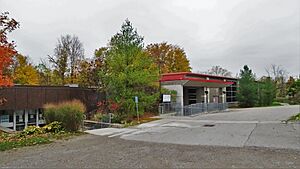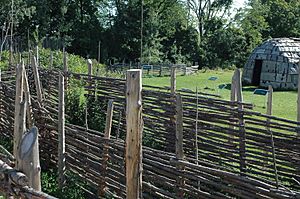Museum of Ontario Archaeology facts for kids
 |
|
| Established | 1933 |
|---|---|
| Location | 1600 Attawandaron Road London, Ontario, Canada N6G 3M6 |
| Type | Archaeology museum |
The Museum of Ontario Archaeology is a cool place to visit in London, Ontario, Canada. It's a museum that helps us learn about over 11,000 years of human history in Ontario. Imagine how much has happened in that time!
Right next to the museum, you can see a rebuilt village. This village shows what life was like for the Attawandaron People (also called the Neutral Iroquoian people) in the 1500s. The museum has special rooms for exhibits, a theatre, and a classroom. There's even a fun space for kids to do activities. You can also take tours of the reconstructed village!
The museum is connected to The University of Western Ontario. It holds more than two million artifacts. These are items found from old archaeological sites all over Ontario. The museum also has labs where experts study these artifacts. Plus, there's a huge library filled with books and papers about archaeology.
The museum hosts four exciting events each year:
- The Annual Harvest Festival and Pow Wow in September.
- An Art & Craft Sale in late November, featuring traditional First Nation art.
- The Snowsnake or Winter Festival on Family Day in February.
- Wilfrid Jury Archaeology Day in late July.
Contents
How the Museum Started
The museum began with a private collection of old items. These items belonged to Amos Jury and his son, Wilfrid. Their collection was first shown at The University of Western Ontario in 1927. Then, in 1933, a special space was set aside for it. This was in the Lawson Memorial Library.
Wilfrid Jury became the first curator of this new museum. It was first called the Museum of Indian Archaeology and Pioneer Life. He worked for free until 1945. Wilfrid Jury stayed involved with the museum until he passed away in 1981.
In 1969, Wilfrid Jury encouraged Colonel Tom Lawson and the Fuller family to donate land. This land included the important Lawson Site. It was given to The University of Western Ontario. The building where the museum is now, called the Lawson-Jury building, was started in 1980 and finished in 1981.
The museum actually sits on two very old archaeological sites. Before the museum building was constructed, experts found an ancient campsite. This campsite is about 4,000 years old! It's now known as the Spook Hollow site. The rebuilt village you can visit is on top of the Lawson site. This was a Neutral Iroquoian village from the 1500s.
The Lawson Site: A 16th-Century Village
The Lawson Site is located on a flat area of land. This land is between the Medway River and Snake Creek. These are small rivers that flow into the Thames River. Around the year 1500 AD, this spot was a large, strong village. It was home to the Neutral Iroquois people. At its busiest, about 1,900 people lived there!
People who collected old items knew about this site since the mid-1800s. The first official digs were done by W.J. Wintemberg from 1921 to 1923. Wilfrid Jury also dug at the site throughout the 1930s and 1940s.
The site was dug up a lot in the 1970s. This was when the Museum of Ontario Archaeology was being developed nearby. The Anthropology Department at The University of Western Ontario still runs a summer field school there. Students learn how to be archaeologists at the Lawson site. It was the first archaeological site in Ontario to be listed on the Canadian Register of Historic Places.
Archaeologists have found the remains of at least 39 longhouses in the village. Longhouses were big homes where many families lived together. They also found many garbage piles (called middens) and pits. The whole village was protected by strong palisade walls. These were tall fences made of logs. There were also defensive earthworks, which are mounds of earth built for protection.
Over 500,000 artifacts have been found at the site. These items tell us a lot about the daily lives of the people who lived there. The people of the Lawson site were farmers. They grew corn, beans, and squash. These three crops are known as the Three Sisters. They grew them in fields around their village.
Museum Connections
The Museum of Ontario Archaeology works with several other groups. These include the CMA and the CHIN. It also works closely with The University of Western Ontario and the Virtual Museum of Canada.
In 2011, a new research building was built next to the museum. It's called Sustainable Archaeology: Western. This is a special place for archaeological research and storing artifacts. Sustainable Archaeology is a team effort between the University of Western Ontario and McMaster University.
Related Pages
- Sustainable Archaeology


